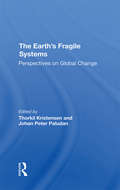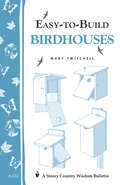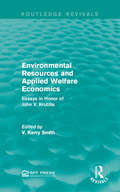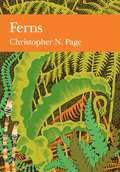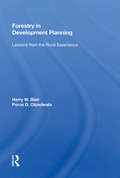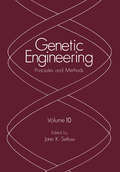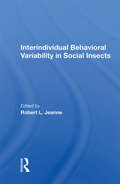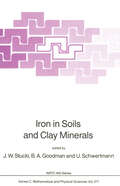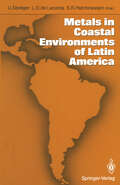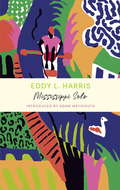- Table View
- List View
The Earth's Fragile Systems: Perspectives On Global Change
by Thorkil Kristensen Johan Peter PaludanThe Earth's Fragile Systems is concerned with some of the most pressing and worrying of the problems afflicting our globe, problems that have been discussed in various forums and are well known not to be simple intellectually, practically or politically.
The Earth's Fragile Systems: Perspectives On Global Change
by Thorkil Kristensen Johan Peter PaludanThe Earth's Fragile Systems is concerned with some of the most pressing and worrying of the problems afflicting our globe, problems that have been discussed in various forums and are well known not to be simple intellectually, practically or politically.
Easy-to-Build Birdhouses: Storey's Country Wisdom Bulletin A-212 (Storey Country Wisdom Bulletin)
by Mary TwitchellSince 1973, Storey's Country Wisdom Bulletins have offered practical, hands-on instructions designed to help readers master dozens of country living skills quickly and easily. There are now more than 170 titles in this series, and their remarkable popularity reflects the common desire of country and city dwellers alike to cultivate personal independence in everyday life.
Effective Writing Strategies for Engineers and Scientists
by Donald C. WoolstonThis easy-to-read, concise book is filled with examples, hints, reminders and reviews designed to help engineers and scientists develop effective writing skills. Use the book to learn to write better reports, memos, and journal articles and keep it close at hand when you have questions about organization, clarity and style, writing and revising rough drafts, graphics, workplace writing, computers in writing, and legal issues in writing. The book also contains four helpful appendices on common errors, equations and abbreviations, preparing manuscripts for publication, and documenting information sources. Effective Writing Strategies for Engineers and Scientists provides easy training for the type of writing required of engineers and scientists, gives specific advise for conveying complicated information, and describes how to synthesize information according to specific writing strategies. It is a "must" for every scientist's and engineer's bookshelf.
Effective Writing Strategies for Engineers and Scientists
by Donald C. WoolstonThis easy-to-read, concise book is filled with examples, hints, reminders and reviews designed to help engineers and scientists develop effective writing skills. Use the book to learn to write better reports, memos, and journal articles and keep it close at hand when you have questions about organization, clarity and style, writing and revising rough drafts, graphics, workplace writing, computers in writing, and legal issues in writing. The book also contains four helpful appendices on common errors, equations and abbreviations, preparing manuscripts for publication, and documenting information sources. Effective Writing Strategies for Engineers and Scientists provides easy training for the type of writing required of engineers and scientists, gives specific advise for conveying complicated information, and describes how to synthesize information according to specific writing strategies. It is a "must" for every scientist's and engineer's bookshelf.
The Ends Of The Earth: Perspectives On Modern Environmental History (Studies In Environment And History Ser. (PDF))
by Donald Worster Alfred W. CrosbySince 1492, when Columbus 'discovered' America, the world has been moving toward an increasingly integrated global economy, higher population levels and consequently greater resource demands, and an increasingly precarious state of the biosphere. These developments play a major part in both modern history and in daily life. Understanding their interrelationships and development is crucial to the future of humanity and of the Earth, and is the unifying theme of this collection of readings.
The Ends Of The Earth: Perspectives On Modern Environmental History (Studies In Environment And History Ser. (PDF))
by Donald Worster Alfred W. CrosbySince 1492, when Columbus 'discovered' America, the world has been moving toward an increasingly integrated global economy, higher population levels and consequently greater resource demands, and an increasingly precarious state of the biosphere. These developments play a major part in both modern history and in daily life. Understanding their interrelationships and development is crucial to the future of humanity and of the Earth, and is the unifying theme of this collection of readings.
Energie und Umwelt als Optimierungsaufgabe: Das MARNES-Modell
by Manfred Walbeck Hermann-Josef Wagner Dag Martinsen Vinzenz BundschuhOptimierungsmodelle werden immer häufiger zur Beschreibung des Verhaltens komplexer Systeme herangezogen. Dieses Buch beschäftigt sich mit den Möglichkeiten und Grenzen des Einsatzes umfangreicher Optimierungsmodelle zur Beantwortung umweltrelevanter Probleme der Energieversorgung. Am Beispiel des in der Systemanalyseforschung in Jülich entwickelten MARNES-Modells wird fast lehrbuchhaft der Weg von der vorgegebenen Fragestellung über die Modellierung selbst bis hin zur Anwendung aufgezeigt. Breiten Raum nehmen die Ausführungen zum Linearen Programmieren und zur datenmäßigen Charakterisierung der Technologien ein. Mit diesem Buch liegt erstmals eine detaillierte Beschreibung eines Energie- und Umweltmodells vor. Das Buch wendet sich an Wissenschaftler in der Systemanalyse und im Operations Research genauso wie an die Praktiker in den Planungsabteilungen der Energiewirtschaft und in den verschiedenen öffentlichen Institutionen.
Environmental Management of Solid Waste: Dredged Material and Mine Tailings
by Wim Salomons and Ulrich FörstnerDredged Material and Mine Tailings are two of the same thing once they are deposited on land: they must be safe-guarded, wash-out must be prevented, and they must be protected by a plantcover. This comprehensive two-volume treatise covers both important aspects of their management: Environmental Management of Solid Waste turns to the practical applications, such as prediction, restoration and management, while in Chemistry and Biology of Solid Waste the principles and assessment are scientifically studied and discussed. Previously, dredged material was a commodity, it could be sold as soil, e. g. to gardeners. In the meantime, dredged material from the North Sea (e.g. the Rotterdam or Amsterdam harbor) must be treated as hazardous waste. Many environmentalists, managers and companies do not know how to solve the inherent problems. This new work deals with the chemical, physical and biological principles; the biological and geochemical assessment; the prediction of effects and treatment; and finally, with restoration and revegetation. It is written by many leading scientists in the various fields, and will prove invaluable for managers and politicians who are concerned with the present environmental situation.
Environmental Resources and Applied Welfare Economics: Essays in Honor of John V. Krutilla (Routledge Revivals)
by V. Kerry SmithThis book, first published in 1988, provides an overview of the diverse work that was being done in applied and theoretical environmental and resource economics. Some essays reflect upon the background of the work of John Krutilla, one of the founders of Resources for the Future and a leading scholar of environmental economics, and the development of the field to date. Other essays examine and convey findings on particular resource problems and theoretical issues and resource policies and the practice of applied welfare economics. This title will be of interest to students of economics and environmental studies.
Environmental Resources and Applied Welfare Economics: Essays in Honor of John V. Krutilla (Routledge Revivals)
by V. Kerry SmithThis book, first published in 1988, provides an overview of the diverse work that was being done in applied and theoretical environmental and resource economics. Some essays reflect upon the background of the work of John Krutilla, one of the founders of Resources for the Future and a leading scholar of environmental economics, and the development of the field to date. Other essays examine and convey findings on particular resource problems and theoretical issues and resource policies and the practice of applied welfare economics. This title will be of interest to students of economics and environmental studies.
Evolutionary Economics: v. 1
by Marc R. ToolThe contributors to this volume focus on the political and value issues that, in their shared view, underlie the global environmental crisis facing us today. They argue that only by transforming our dominant values, social institutions and way of living can we avoid ecological disaster.
Evolutionary Economics: v. 1
by Marc R. ToolThe contributors to this volume focus on the political and value issues that, in their shared view, underlie the global environmental crisis facing us today. They argue that only by transforming our dominant values, social institutions and way of living can we avoid ecological disaster.
Ferns (Collins New Naturalist Library #74)
by Christopher N. PageFerns gives the reader an introduction to the reasons for the variety of ferns in the British Isles, as well as the history of their development within this landscape and their use by man. This edition is exclusive to newnaturalists.com
Forestry In Development Planning: Lessons From The Rural Experience
by Harry W. BlairThis book explores some of the relationship between forestry and rural development focusing on lessons that the overall experience in rural development might have for social forestry. It examines a single social forestry project to see how it would look from a rural development perspective.
Forestry In Development Planning: Lessons From The Rural Experience
by Harry W. BlairThis book explores some of the relationship between forestry and rural development focusing on lessons that the overall experience in rural development might have for social forestry. It examines a single social forestry project to see how it would look from a rural development perspective.
Genetic Manipulation of Woody Plants (Basic Life Sciences #44)
by James W. Hanover Daniel E. KeathleyThis Volume contains the papers presented by twenty-eight invited speakers at the symposium entitled, "Genetic Manipulation of Woody Plants," held at Michigan State University, East Lansing, Michigan, from June 21-25, 1987. Also included are abstracts of contributed poster papers presented during the meeting. That the molecular biology of woody plants is a rapidly expanding field is attested to by the large attendance and high level of enthusiasm generated at the conference. Leading scientists from throughout the world discussed challenging problems and presented new insights into the devel opment of in vitro culture systems, techniques for DNA analysis and manipulation, gene vector systems, and experimental systems that will lead to a clearer understanding of gene expression and regulation for woody plant species. The presence at the conference of both invited speakers and other scientists who work with nonwoody plant species also added depth to the discussions and applicability of the information presented at the conference. The editors want to commend the speakers for their well-organized and informative talks, and feel particularly indebted to the late Dr. Alexander Hollaender and others on the planning committee who assist ed in the selection of the invited speakers. The committee consisted of David Burger (University of California, Davis), Don J. Durzan (University of California, Davis) , Bruce Haissig (U. S. Department of Agriculture Forest Service), Stanley Krugman (U. S. Department of Agriculture Forest Service) , Ralph Mott (North Carolina State University), Otto Schwarz (Univer.sity of Tennessee, Knoxville), and Roger Timmis (Weyerhaeuser Company).
Interindividual Behavioral Variability In Social Insects
by Robert L. JeanneThis book represents empirical studies of some aspect of the phenomenon of variability in social insect behavior. It illustrates the range of ways colony members can differ from one another and interprets the variability in terms of the external environment, social context, or individual experience.
Interindividual Behavioral Variability In Social Insects
by Robert L. JeanneThis book represents empirical studies of some aspect of the phenomenon of variability in social insect behavior. It illustrates the range of ways colony members can differ from one another and interprets the variability in terms of the external environment, social context, or individual experience.
Iron in Soils and Clay Minerals (Nato Science Series C: #217)
by J.W. Stucki B.A. Goodman U. SchwertmannProbably more than any other element, iron markedly influences the chemical and physical properties of soils and sediments in the earth. Considering its transition metal status, with potential variation in electronic configuration, ionic radius, and magnetic moment, combined with its abundance and relatively large mass, little wonder that one sees its unique influence on every hand. Pre sentations at the NATO Advanced Study Institute (NATO AS!) on Iron in Soils and Clay Minerals reviewed and discussed the occurrence, behavior, and properties of Fe-bearing minerals found in soils and in the clay mineral groups kaolinite, smectite, and mica. Also discussed at the NATO AS! were the basic chemical properties of Fe, methods for separating and identifying Fe in minerals, and the role of Fe minerals in weathering and other soil-forming processes. The present publication is the reviewed and edited proceedings of that Advanced Study Institute. The sequence of chapters follows the general pattern beginning with introductory chapters which overview the general occurrence of Fe in the earth and its chemistry, both generally and in mineral environments, followed by identification and characterization methods for Fe and Fe phases in minerals. The properties and behavior of Fe oxides, Fe-bearing clay minerals, and other Fe minerals in soils are then described, and the text ends with a summary of the role of Fe in soil-forming processes. A Table of Contents and subject index are provided to assist the reader in finding specific topics within the text.
Manganese in Soils and Plants: Proceedings of the International Symposium on ‘Manganese in Soils and Plants’ held at the Waite Agricultural Research Institute, The University of Adelaide, Glen Osmond, South Australia, August 22–26, 1988 as an Australian Bicentennial Event (Developments in Plant and Soil Sciences #33)
by R. D. Graham R. J. Hannam N. C. UrenSixty years ago at the Waite Agricultural Research Institute, G. Samuel, a plant pathologist, and C. S. Piper, a chemist, published their conclusion that the cause of roadside take-all, a disease of oats, was manganese deficiency. This report, together with the concurrent and independent studies of W. M. Carne in Western Australia were the first records of manganese deficiency in Australia and came only six years after McHargue's paper which is generally accepted as the final proof of the essentiality of this element. There must have been a few doubts for some people at the time, however, as the CAB publication, 'The Minor Elements of the Soil' (1940) expressed the view that further evidence to this effect was provided by Samuel and Piper. Their historic contributions are recognised by the International Symposium on Manganese in Soils and Plants as it meets on the site of their early labours to celebrate the 60th anniversary. This year Australians also acknowledge 200 years of European settlement in this country and so the Symposium is both a Bicentennial and a diamond jubilee event which recognises the impact of trace elements on agricultural development in Australia. In a broader sense, a symposium such as this celebrates, as it reviews, the efforts of all who over the ages have contributed to our knowledge of manganese in soils and plants.
The Mathematics of Blunt Body Sampling (Lecture Notes in Engineering #38)
by Sarah J. Dunnett Derek B. InghamParticle samplers are widely used in workplaces in order to determine the concentration of airborne particles in the atmosphere. They generally operate by drawing air, with the aid of a pump, through one or more orifices in the sampler body and housed within the sampler is a filter through which the air is subsequently drawn. The airborne particles are collected on the filter and their concentration is determined. Various samplers have been designed for this purpose including "static" samplers, which are located in a fixed position in a working environment and determine the dust concentration averaged over a prescribed period of time at that one point, and "personal" samplers which are mounted on a working person near to the breathing zone. The ORB sampler, a static sampler designed by Ogden and Birkett (1978) to have approximately the same entry efficiency, for particles with aerodynamical diameter up to at least 25~m, as a human head equally exposed to all wind directions for wind speeds between 0 and 2. 75m1s, is shown in Fig. l. l and examples of personal samplers are shown in Fig. 1. 2a, b and c and represent a single 4mm hole sampler, a seven hole sampler and a 25mm open face filter holder respectively. These three samplers are some of the most commonly used personal samplers for sampling the total airborne concentrations of workplace dusts in Britain.
Metals in Coastal Environments of Latin America
by S. R. Patchineelam Luiz DrudeLacerda UlrichSeeligerFor the first time a state-of-the-art of present metal pollution along the coastline of Latin America is provided. This collection of papers from a conference held in August 1986 in Rio de Janeiro, Brazil is designed to inform readers of recent advances in an important, interdisciplinary field. Primary focus is on: - Metal Surveys, Metals in Sediments, Metals in Biota, Metal Transport and Cycles, Metal Monitoring. A final chapter combines conclusion, outlook and recommendations of how to master the critical situation of metal concentrations in coastal environments of Latin America. This book fills a long-standing gap in the literature and will be of prime interest to researchers, students and professionals in geology, biology and chemistry.
Mississippi Solo: John Murray Journeys (Overcoming Books)
by Eddy L HarrisINTRODUCED BY ADAM WEYMOUTH, award-winning author of The Kings of Yukon'A wonderful book -- and a highly original contribution to the literature of travel' PAUL THEROUX'The Mississippi. Mighty, muddy, dangerous, rebellious and yet a strong, fathering kind of river. The river captured my imagination when I was young and has never let go.' Mississippi Solo tells the story of one man's voyage by canoe down the Mississippi River from its source in Minnesota to the Gulf of Mexico - a longtime dream, and a journey of over 2,000 miles through the heart of America. Paddling into the Southern states - going from 'where there ain't no black folks to where they still don't like us much' - Eddy is confronted by the legacy of slavery and modern racism, including an incident with a pair of shotgun-toting bigots. There are also the dangers of passing barges, wild dogs roaming the wooded shore, and navigating a waterway that grows vaster, and more hazardous, every day. But Eddy also encounters immense human kindness, friendship and hospitality, as well as coming to know the majestic power - and the awesome dangers - of the river itself. Mississippi Solo is an unforgettable American adventure.
